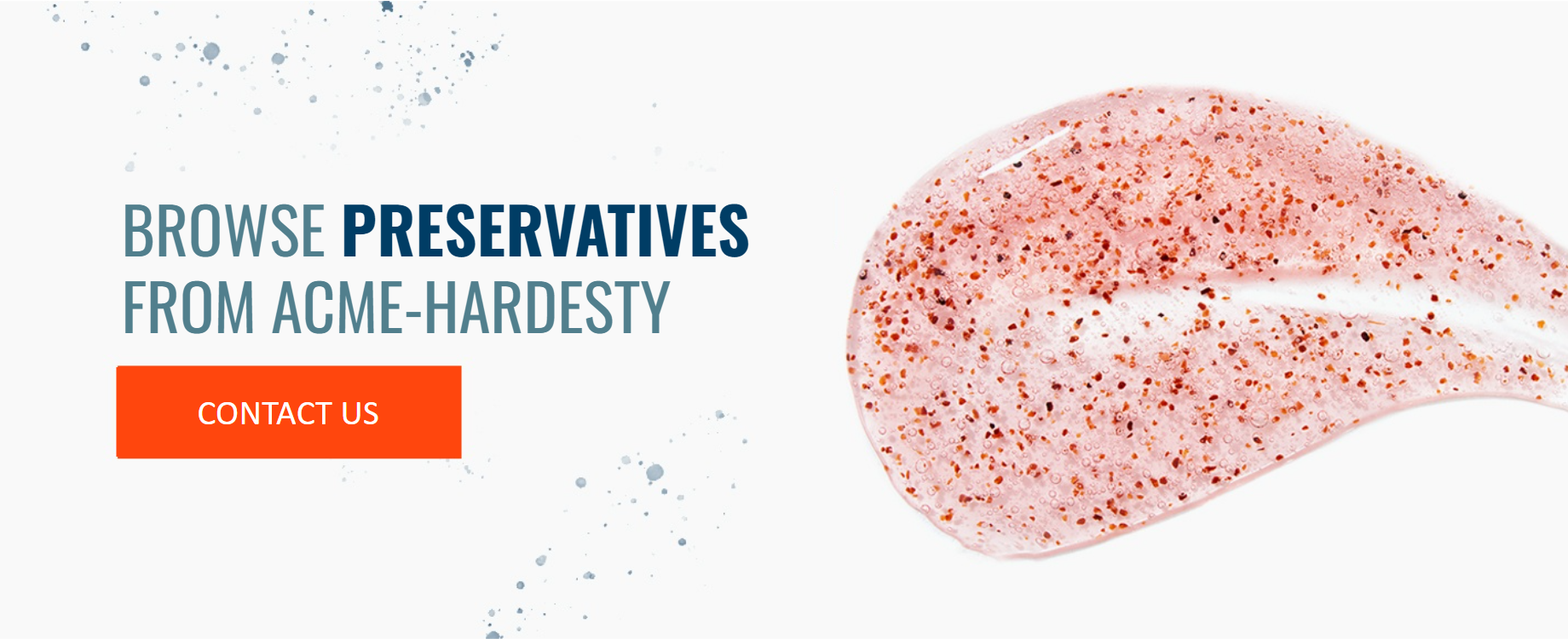The Truth About Parabens: What You Should Know
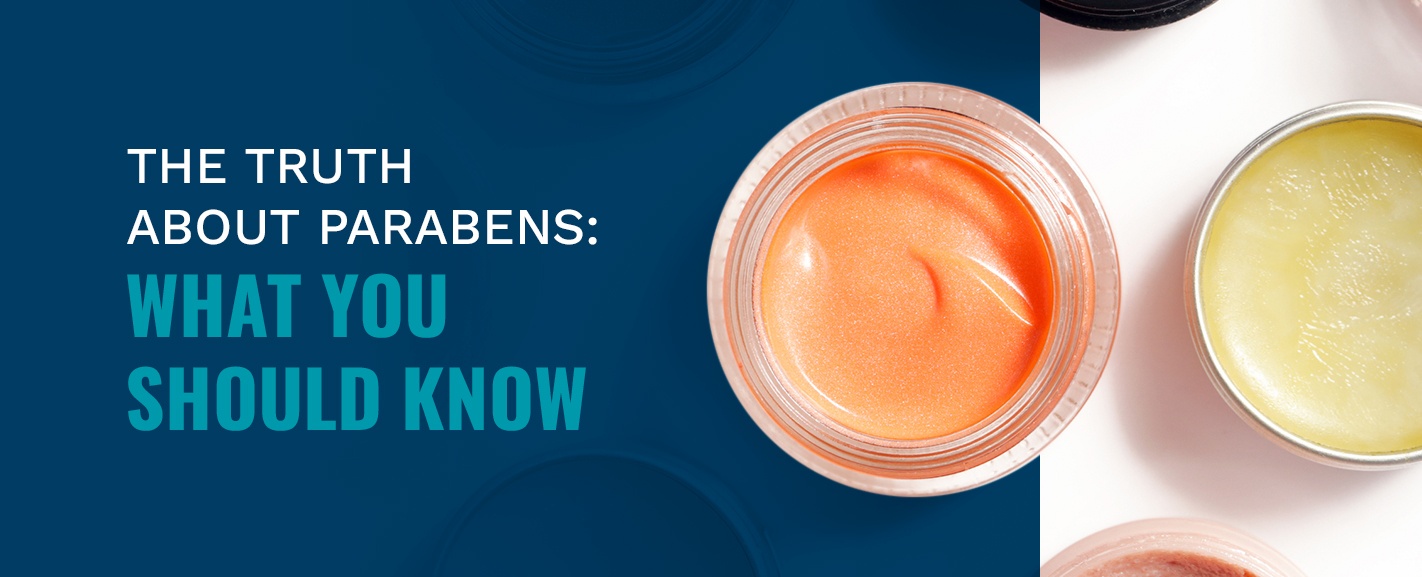
If you’ve noticed the packaging or ads for any number of cosmetic or hygiene products, you may come across the phrase “paraben-free.” That label inspires fear in many consumers. They wonder what parabens are and if parabens are safe. If not, why would other products use this ingredient? Unfortunately, many consumers don’t know the truth about parabens.
Maybe you’re on the fence about using products with parabens, or you aren’t sure if you should include the ingredient in your own products. A little knowledge about this ingredient and the importance and uses of parabens goes a long way. Once you know the truth about parabens, you’ll see why they are thought to be bad and why they’re actually beneficial. First, you should learn what parabens are and understand their purpose. Take a look at what you should know about parabens for a more informed understanding.
What Are Parabens?
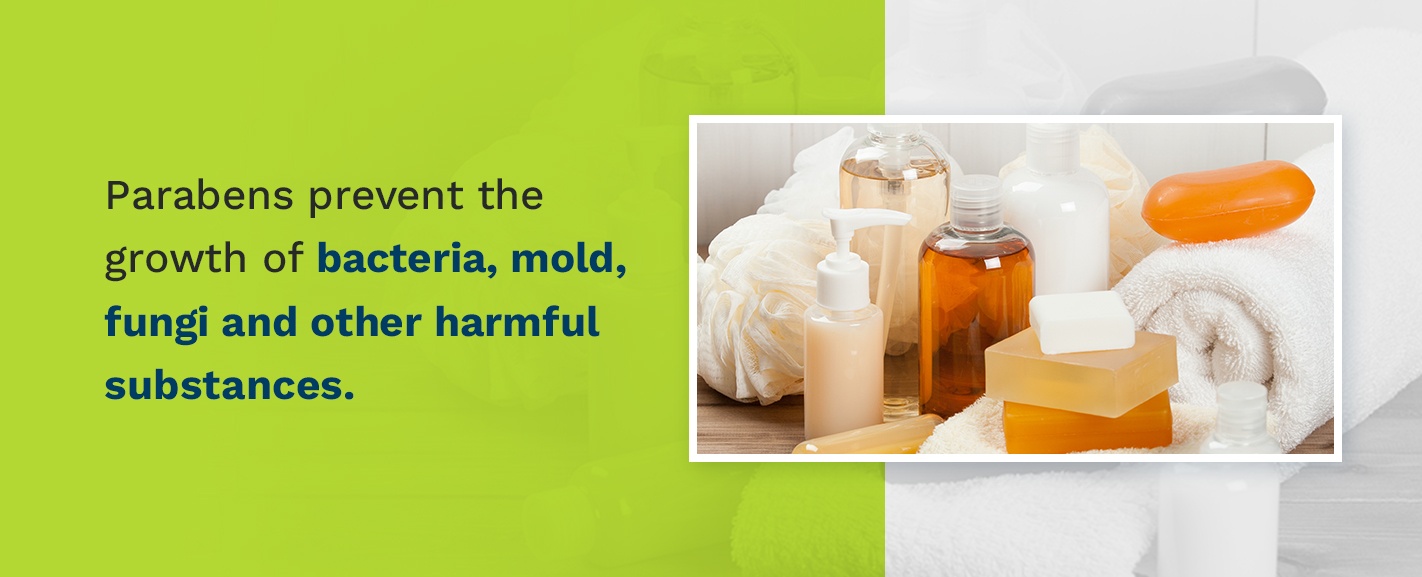
When manufacturers emphasize paraben-free products, many consumers may wonder — what are parabens? Parabens serve as preservatives for an array of industries, including:
- Cosmetic
- Personal hygiene
- Pharmaceutical
- Food products
These preservatives are useful in products across these industries and others. The main appeal is that they provide a longer shelf-life. Parabens prevent the growth of bacteria, mold, fungi and other harmful substances. They are also colorless and odorless, making them ideal for use in the above industries. With those qualities, parabens will not alter the appearance, scent or flavor of products.
Parabens are derived from something called para-hydroxybenzoic acid (PHBA). PHBA is a natural substance that appears in a variety of fruits and vegetables, such as cherries, blueberries, cucumbers and more. You can even find natural PHBA in human bodies as a result of the breakdown of some amino acids. In commercial applications, manufacturers produce parabens in synthetic ways. The results are still identical to parabens found in nature.
How Do Parabens Work?
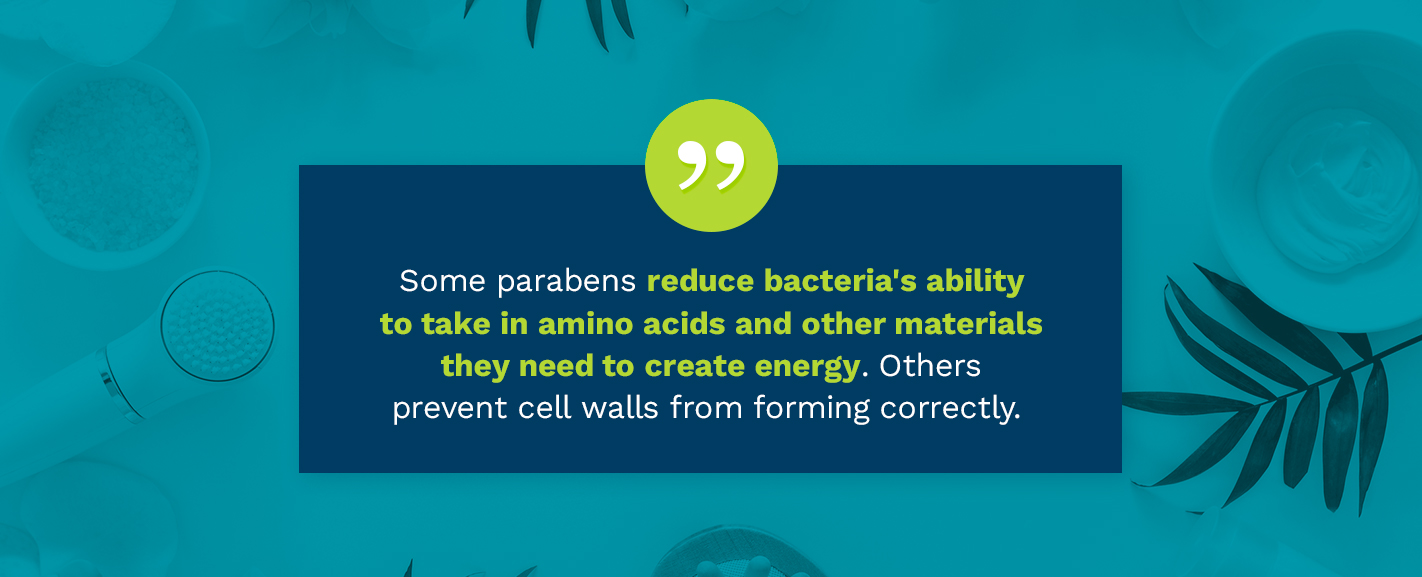
In cosmetics, hygiene products, food and other goods, you may find various types of parabens, such as these common varieties:
- Methylparaben
- Ethylparaben
- Propylparaben
- Butylparaben
Don’t let the names intimidate you. These are common commercial parabens that you may find in a variety of products. But how do parabens work? The varieties above and others work in several ways to prevent bacteria and other dangerous substances like mold, yeast or fungi.
Some parabens reduce bacteria’s ability to take in amino acids and other materials they need to create energy. Others prevent cell walls from forming correctly. As a result, bacteria are unable to reproduce or sustain themselves.
Many manufacturers use two or more varieties of parabens in a single product to increase their effectiveness. If those parabens work in different ways to stop bacteria growth, they can be more successful together.
Why Are Parabens Thought to Be Bad?
As more and more products advertise a paraben-free ingredients list, many consumers develop a fear of the preservative. This fear, along with necessary regulations on cosmetics, food and other products, has lead to various studies of parabens.
Some believe parabens to be endocrine-disrupting, also known as hormone-mimicking. Such a quality is believed to contribute to or cause cancer, particularly breast cancer. That belief comes from how hormone-mimicking substances can disguise themselves as estrogen. But researchers have conducted these studies on animals while using higher doses of parabens than someone would experience in their lifetime. Other scientists have discredited these studies, finding instead that there is no direct link between parabens and cancer.
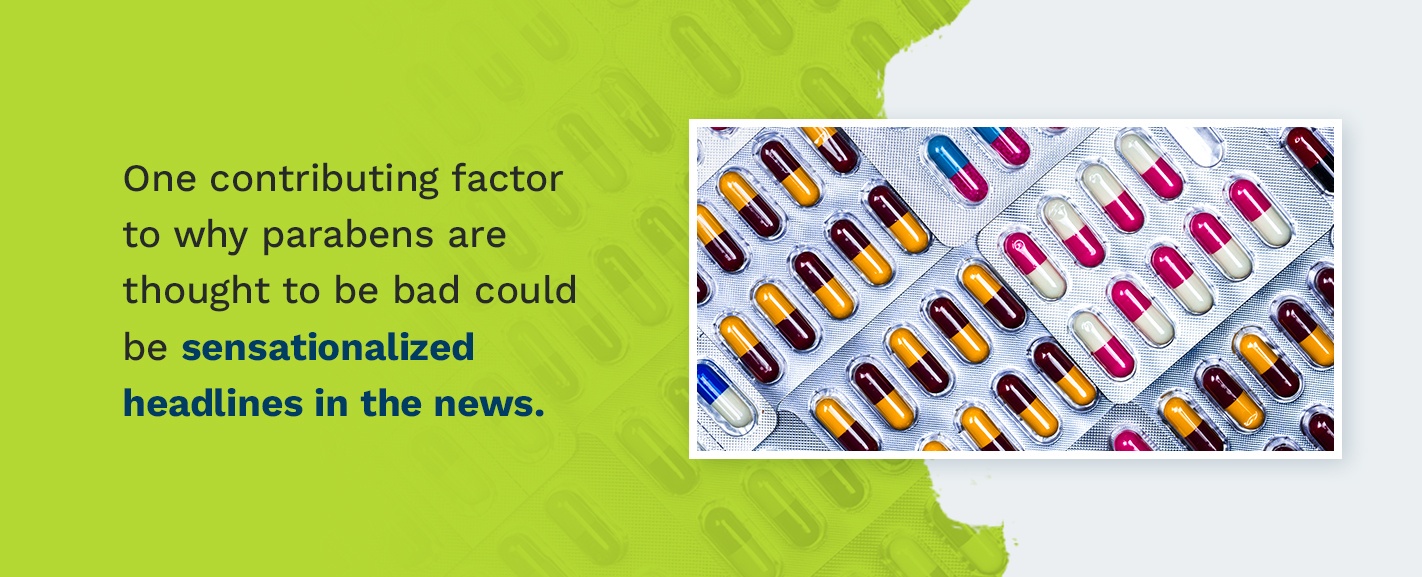
One contributing factor to why parabens are thought to be bad could be sensationalized headlines in the news. Even if the report or article takes an in-depth look at research, the headline is often crafted to inspire a reaction. Some readers may take the headline at face value rather than reading further.
The concern about parabens seems to have stemmed from the discovery of them in breast cancer tumors. That discovery was then associated with antiperspirant use. A closer look at the study reveals some factors that many news outlets set aside in favor of sensationalizing scientific reports:
- Study participants: The scientific study that news articles referenced only tested tissue from 40 women with breast cancer. The two main issues with that sample are the small size and the fact that researchers did not test women without breast cancer. Parabens may be found in the tissue of individuals without cancer, but the study failed to examine that possibility. Instead, it seemed to link parabens to cancer.
- The source of the parabens: While many tabloids and news outlets reported that antiperspirants were to blame, the study could not determine a source of the parabens. Seven of the 40 women involved in the study claimed never to have used underarm antiperspirant throughout their lives.
- The strength of the hormones: Parabens in this study were seen to be hormone-mimicking. But these parabens had weak estrogen-like properties. Natural estrogen or that from hormone replacement is stronger than that from the parabens. According to the American Cancer Society, natural or hormone replacement estrogen is more likely to have a role in the development of breast cancer than parabens.
- The conclusion: In the study, the researchers concluded that their results do not imply that parabens cause cancer. Instead, the study served to explore how parabens may be deposited in human tissue. Media outlets, in an attempt to create articles and stories that would appeal to their audiences, offered the wrong interpretation of the study.
So why are parabens thought to be bad if studies like this haven’t claimed to make any connections between the preservative and cancer? As tabloids and other media outlets reported the study with sensationalized headlines, they created potentially unnecessary fear. Many readers only focus on the headlines or fail to question the study and repeat what they believe to be true.
Those myths and rumors circulate until many manufacturers feed into the fear by selling paraben-free products. With those products on the market, many consumers who are unaware of these claims and studies believe the ingredient to be dangerous, and the cycle continues.
Other myths about parabens include the belief that parabens are banned outside of the United States. The truth is that government agencies around the world have permitted parabens for use in cosmetics and other industries. Some locations that have approved of parabens include Canada, Japan and Australia.
Other studies around parabens may lead consumers to fear the preservative. Consider a study by the Centers for Disease Control and Prevention (CDC) between 2005 and 2006. Most of the tested participants had results that indicated exposure to parabens, and women had higher concentrations of the substance.
These results, however, do not imply toxicity or other adverse health effects. Instead, this study — known as biomonitoring — can help physicians have an average reference to determine future exposure levels in patients. The next time you see a headline about how an ingredient may be harmful, especially parabens, be sure to read into the research before accepting the headline as the truth.
Are Parabens Safe?
So are parabens safe? As it is the case with many ingredients, products or substances, lower quantities are safer. But in studies exploring extremely high doses of parabens that may have deemed the preservative dangerous, those high quantities exceed what the average human will come in contact with throughout their life.
What many consumers may not understand is that parabens in small levels are not toxic. In fact, the human body is capable of changing parabens into PHBA, breaking it down and eliminating it from your system. You may only be at risk for negative side effects from extremely frequent and high levels of parabens, which products today just don’t contain.
If you or someone you know has had reactions to certain products with parabens, you may wonder — is paraben safe for skin? Some individuals with sensitive skin or allergies may experience some reactions to products with parabens, especially cosmetic or hygiene products. In those situations, an individual may want to avoid parabens for the slight skin reaction that occurs. Those minor reactions can include:
- Itching
- Bumps
- Dry skin
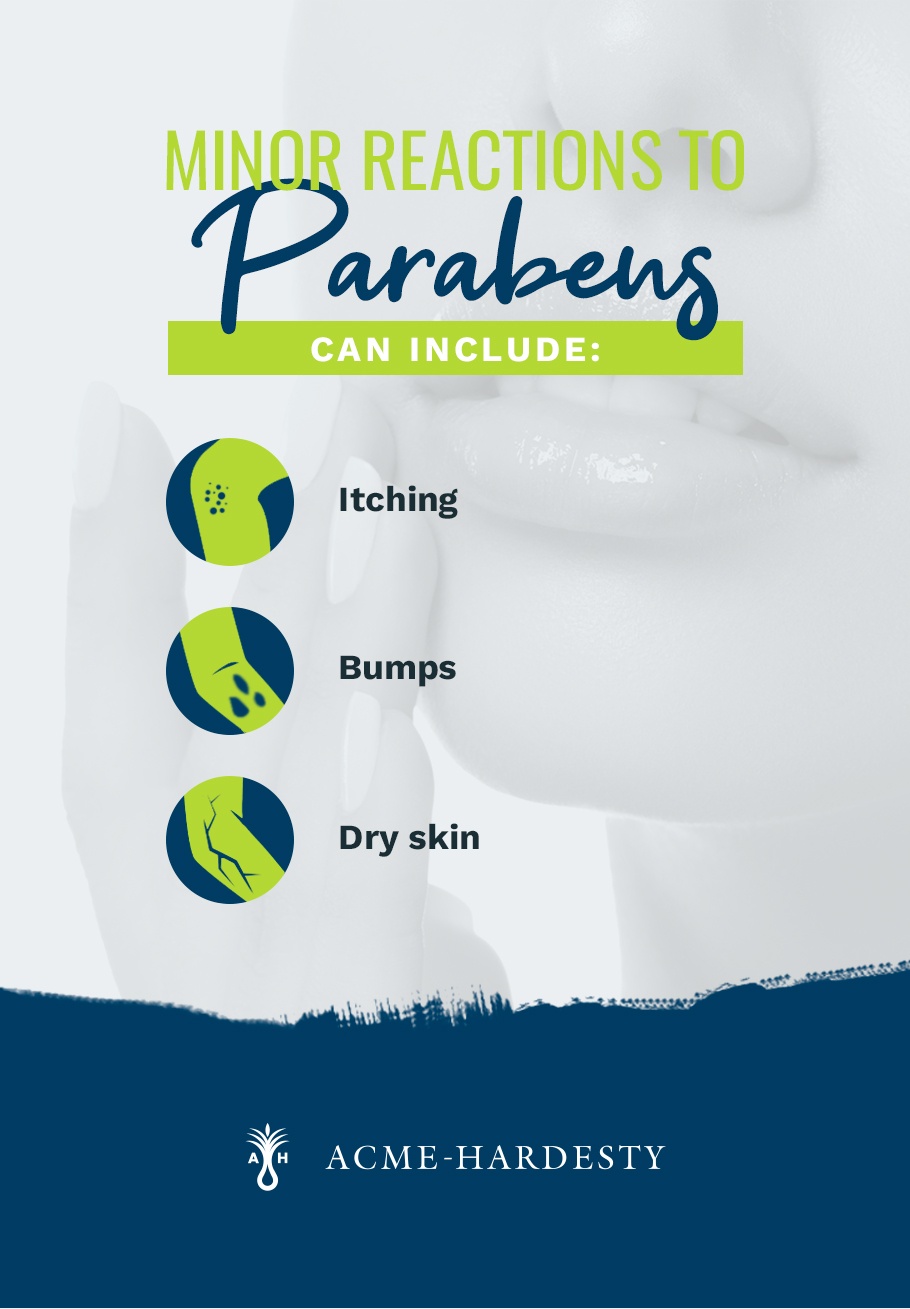
Allergic reactions can occur with any variety of cosmetic ingredients, not just parabens. If you have sensitive skin or other allergies, you may want to pay closer attention to the ingredients in your products. But an allergic reaction from some consumers does not indicate that an ingredient is dangerous, just as someone having a peanut allergy wouldn’t mean that peanuts are dangerous for others.
As is the case with many ingredients in an array of industries, pregnant individuals and children may wish to avoid parabens due to increased sensitivity. This does not necessarily reflect on paraben as a dangerous ingredient. Rather, it is common advice for these groups of consumers.
Even if you wish to avoid parabens, that may be a difficult task. According to Scientific American, researchers have found that about 90% of typical grocery items contain amounts of parabens. These levels are safe enough to consume per the Food and Drug Administration’s (FDA) standards but are still measurable.
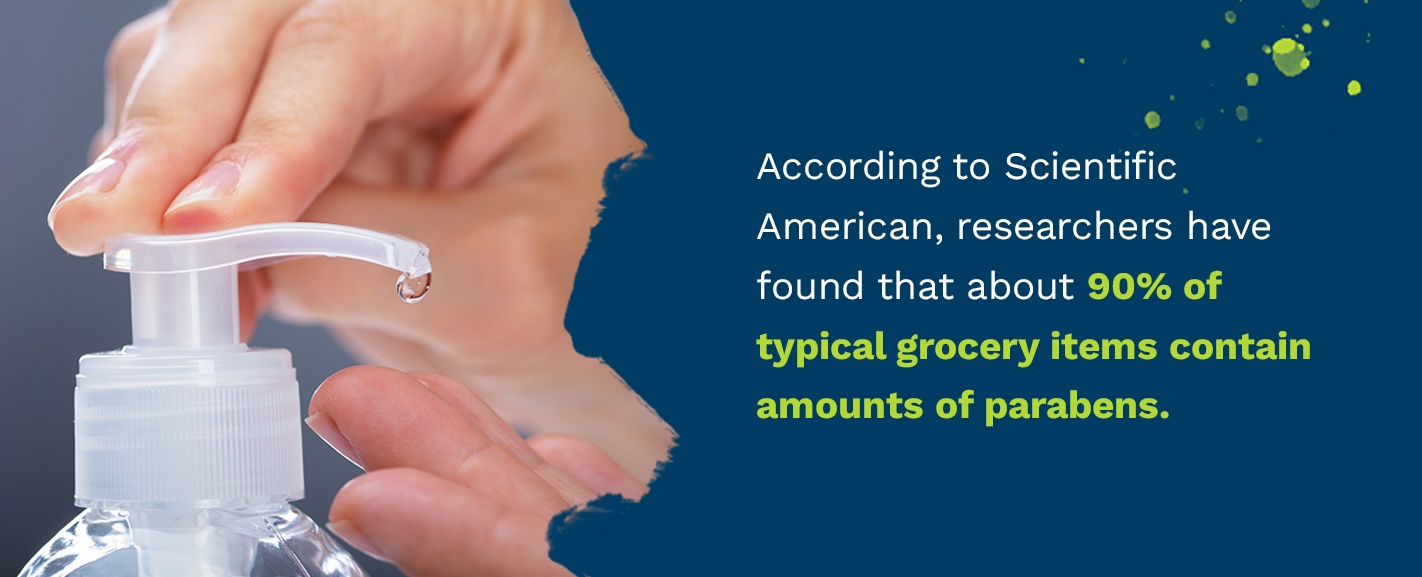
Other than the inclusion in food items, are parabens safe in cosmetics, skincare and other health products? The Environmental Working Group’s (EWG) Skin Deep® project tests an array of brands and ingredients to verify the safety of products and inform consumers. In their research, they evaluate an array of an ingredient’s qualities, such as:
- Its potential danger to cause cancer
- Its potential developmental and reproductive toxicity
- Its potential immunotoxicity and potential to cause allergies
- Any restrictions on the ingredient
- Any possible environmental toxicity
- The possibility to be bioaccumulative or persistent
Those factors help contribute to a score, which also considers the amount of data available on a certain ingredient or product. The scores range from:
- One to two: This score reflects an ingredient or product that the EWG considers a low hazard. They may also have a fair, good or robust amount of data on the subject.
- Three to six: A product or ingredient with this score represents a moderate hazard. There may be less data about this subject.
- Seven to 10: A higher number means a higher hazard and potentially little data about a product.
As you explore the EWG’s database of ingredients and products, be mindful of the level of data for a particular item. An ingredient may be a hazard primarily because of the lack of research on the subject.
Many consumers’ fear of parabens revolves around whether or not they are cancer-causing. The EWG has found that a variety of parabens have no link to cancer, as revealed by government, academic or industry studies. Those varieties include propylparaben, butylparaben, ethylparaben and methylparaben. In fact, the American Cancer Society states that researchers have discovered no link between antiperspirant use and breast cancer. These conclusions reflect what researchers have found but media outlets have misconstrued over time.
Does the FDA Regulate Parabens in Cosmetics?
It may at first be alarming to hear that the FDA does not regulate preservative ingredients in cosmetic items. However, this is the case for most ingredients in cosmetics. While they may not regulate specific components of cosmetics, they still have requirements for manufacturers to meet. Those requirements help keep consumers safe.
The FDA’s cosmetic restrictions and rules state:
- Cosmetic ingredients and the products themselves do not need FDA approval
- Color additives do need FDA approval
- You cannot market cosmetics in interstate commerce if they are poor quality or mislabeled
- Cosmetics can’t be dangerous for customers when they use products according to package directions
- Or, cosmetics must be safe when consumers use them in the expected way
- Packages must be properly labeled with directions
- Cosmetics, whether sold in-store or online, must list their ingredients
Because makeup products must list their ingredients, you can feel safer as a consumer as long as you know what to look for on the label. In cosmetics, the packaging may list parabens as some of the specific names we mentioned above — methylparaben, ethylparaben, propylparaben or butylparaben. This is essential for those with allergies to parabens or other ingredients in cosmetics to stay safe.
While the FDA does not regulate cosmetic ingredients, it will take action against manufacturers or specific cosmetic products that are not safe for consumers. The only restriction with taking action is that there must be sufficient scientific evidence that the product is dangerous.
To continue to ensure the safety of cosmetic products, the FDA conducts research and asks questions about makeup ingredients. Staying vigilant helps ensure that the FDA can conduct necessary research to prove the safety and effectiveness or hazards of ingredients. For parabens, some questions the FDA considers are:
- Do research findings with parabens reflect real life?
- What are the hazards of not using parabens?
- Are there even safer alternatives to necessary preservatives?
- How do any effects of parabens found in research relate to cosmetics?
- Do different parabens have differing effects on our bodies?
Even consumers can analyze some of these questions for themselves. When they do so, they will get closer to knowing the truth about parabens.
Why Do We Need Parabens in Cosmetics?
These preservatives may be safe, but why are parabens important, especially in makeup? Because cosmetic products go on our skin and around our eyes and mouths, we don’t want to use anything harmful. But as you’ve seen, the most significant risk from parabens may be an allergic reaction, which does not indicate that the ingredient is toxic. Instead, parabens help keep makeup safe for use.
A closer look at a variety of makeup products may reveal parabens on the ingredient list. Among the list of cosmetics that may contain one or more forms of parabens are mascara, eyeliner and eyeshadow.
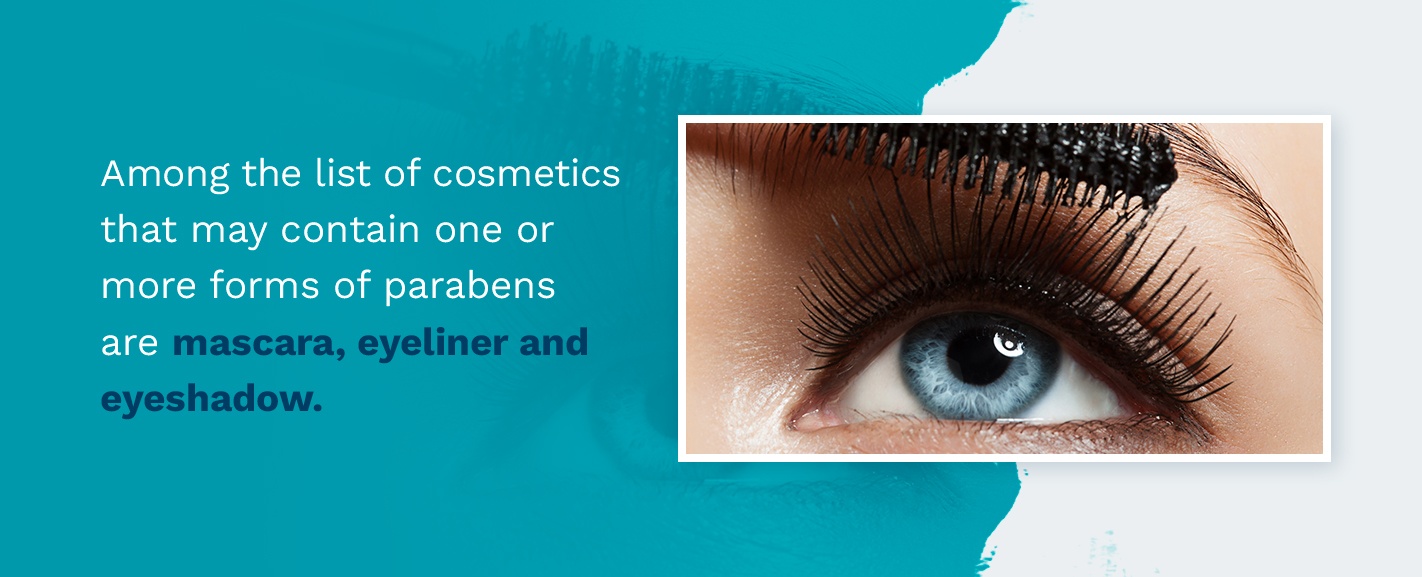
With all of these products going near your eye in some way, you can see why it’s essential that they remain free of mold, bacteria and other potentially harmful microorganisms. If bacteria, fungi, mold, yeast or more get into your makeup products, they will transfer to your skin or eyes, which can cause infection. While it is important to note the expiration dates or shelf-lives of your cosmetics, it’s also essential to choose ones with effective preservatives that fight against bacteria growth.
While the myths and concerns about these preservatives may seem recent, parabens have been used in the cosmetic industry since the 1920s. At that time, they replaced preservatives that were capable of releasing formaldehyde — an ingredient that is known to have more of a negative impact on health in contrast to parabens.
Along with a century of use comes extensive research from an assortment of government, academic and industry studies. In 1984, the Cosmetic Ingredient Review (CIR) concluded that parabens are safe for use in cosmetics. In 2006, CIR and the FDA revisited this conclusion and determined it was still accurate. Revisiting past research shows a continuous dedication to exploring the potential impact of parabens on consumers.
In that research, professionals have discovered various purposes and uses of parabens, especially for makeup. Those benefits of parabens include the ability to:
- Extend the shelf-life: Cosmetic products have shelf-lives for your protection. Once you open and use a product, you expose your cosmetics to substances that could compromise them and render them useless. Parabens work to help eliminate that risk and extend the shelf-life of your products.
- Protect from harmful substances: Bacteria, mold and other unwanted substances can cause a lot of problems for cosmetics. With the presence of these microorganisms, cosmetics are more likely to spoil or become contaminated, which can be harmful to your health. Within 11 days, cosmetics without parabens can have plenty of bacteria growth in contrast to cosmetics with parabens, which experience little to no growth.
- Prevent discoloration: When microorganisms grow in cosmetics, the product can become discolored. While you should avoid using products that have gone off, if you were to try these cosmetics, you’d be disappointed in the discoloration that has altered the makeup from what you originally purchased.
The FDA requires that manufacturers must ensure their products are free of microorganisms, such as bacteria. To do this, cosmetic companies ensure proper manufacturing conditions and use preservatives in their products. Those preservatives help maintain cosmetic goods once they reach consumers. While makeup and other products may not contain microorganisms when you buy them, opening them and using them exposes them to bacteria and other substances.
To achieve the benefits of parabens, cosmetics only need a small amount. Such a low level makes the ingredient nontoxic and, again, does not reach the high doses that researchers use in experiments.
Uses and Benefits of Parabens
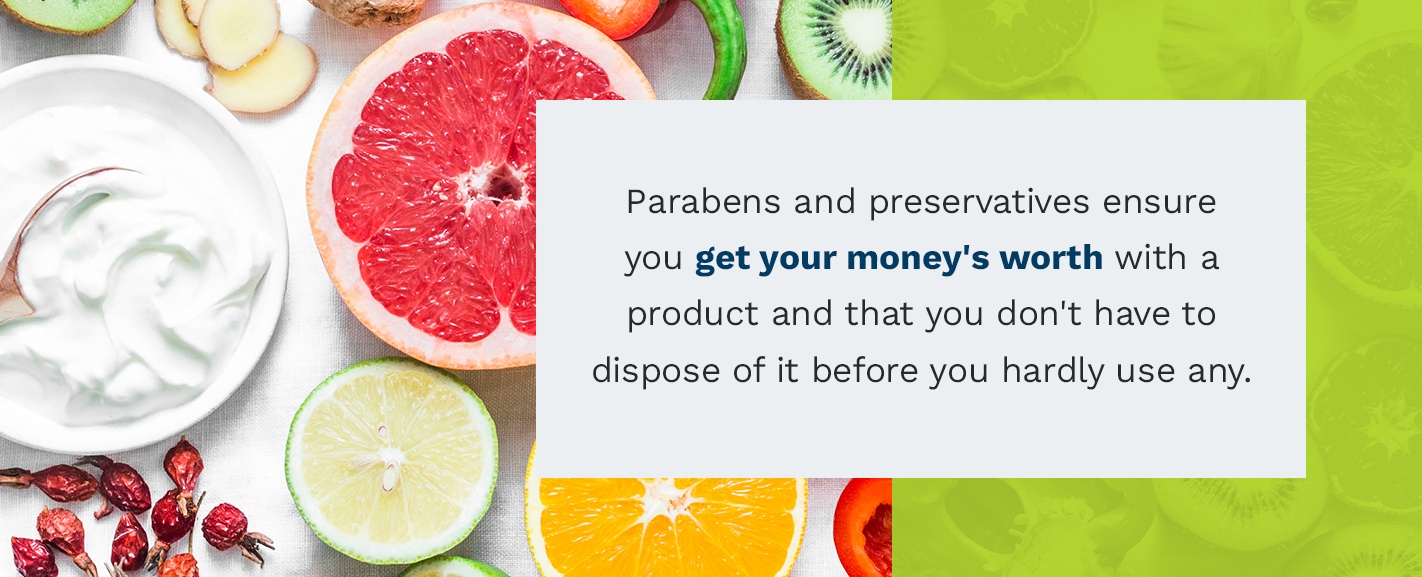
Parabens appear across various industries for their usefulness and benefits. From food to personal hygiene items, parabens bring these advantages:
- Saving consumers money: As a customer, you want your products to last for a reasonable amount of time. Parabens and preservatives ensure you get your money’s worth with a product and that you don’t have to dispose of it before you hardly use any.
- Ability to help reduce waste: Consumers won’t have to throw out products or buy replacements as often with a longer shelf-life. That could reduce waste created by both unused products and packaging.
- Safe for the environment: Parabens that are identical to those found in nature are not suspected to be environmental toxins, according to the EWG. The EWG references the Environment Canada Domestic Substance List for parabens such as methylparaben and ethylparaben. There have been studies that show an impact on wildlife. But these studies often use high concentrations that would not be found in nature or obtained through product use by humans. As long as you dispose of products in the proper way, you’re not likely to increase paraben levels to dangerous numbers.
When you understand what an ingredient does for a product, its name becomes less intimidating. When you discover that many beliefs you have about an ingredient, especially parabens, are myths, you can use more cosmetics and other goods without fear.
Browse Preservatives From Acme-Hardesty
Knowing the truth about parabens and preservatives may have you ready to make the addition to your own products. If that’s the case, browse our preservatives at Acme-Hardesty.
With our focus on sustainable, bio-based solutions, we want to give you an easy and efficient way to get smaller quantities of oleochemicals than other companies offer. You’ll shop with confidence knowing you’re getting high-quality ingredients.
At Acme-Hardesty, we have the right size and solution for your needs. Browse our products and ask us about our preservatives and parabens today.
